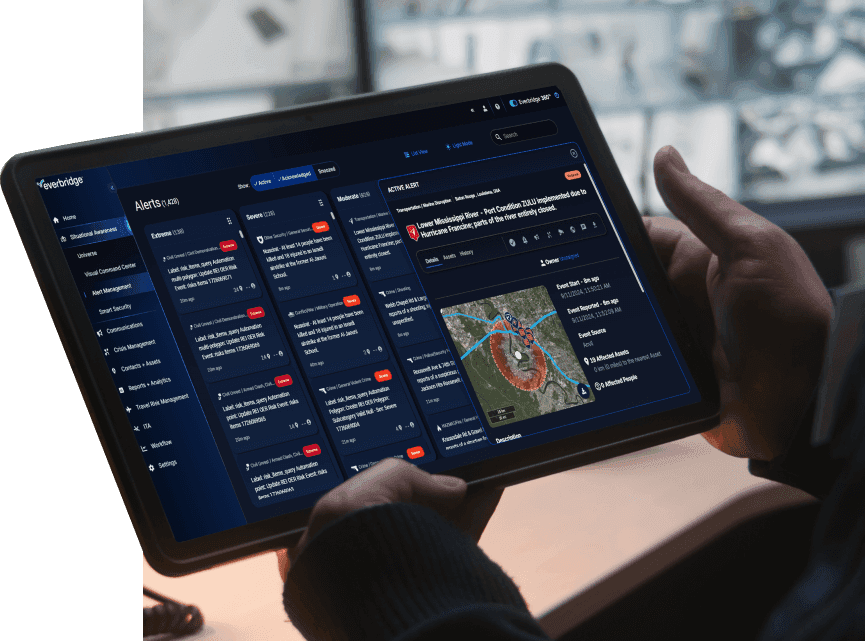Technology runs through every part of a modern business. It powers remote work, automates operations, and helps deliver better experiences for customers. As digital transformation picks up speed, IT systems become more essential. But they also become more exposed to risk. Whether it’s a cyberattack, a service outage, or a failure in operations, these events aren’t rare. They’re part of doing business now.
This is why IT resilience matters. It’s more than just bouncing back from a problem. It’s about being ready, staying steady, and keeping things moving when challenges come up. And it’s not something that sits in the background. At Everbridge, we bring this to life with High Velocity CEM, a system that helps teams respond faster, stay coordinated, and keep improving. It uses Purpose-built AI to make sense of complex risks and turn insight into action.
Let’s look at how this kind of resilience gets built.
Why IT resilience has become a must-have
Downtime costs add up fast. According to Gartner, one minute of IT downtime can cost over $5,000. In high-stakes industries like healthcare and finance, the impact runs even deeper. There’s loss of revenue, customer frustration, and exposure to regulatory trouble.
The main drivers behind these disruptions include:
- Cyber threats: Attacks like ransomware and data breaches are more frequent and more advanced.
- System complexity: With cloud platforms, connected devices, and AI tools, there are more moving parts, and more ways things can go wrong.
- Higher expectations: People expect services to work all the time. Even a short disruption can cause lasting damage to trust.
Tools like High Velocity CEM are designed for this kind of environment. They help teams stay ahead by turning early signals into coordinated response.
Three principles of IT resilience
To build lasting resilience, businesses need more than backup plans. They need to build smarter, more responsive systems from the ground up.
1. Understand risk before it happens
Resilience starts with knowing where you’re vulnerable. This means taking a close look at systems and spotting weak points. The best teams do this on a regular basis. They test their systems, simulate threats, and act on what they learn.
For example, a financial services firm we work with runs regular cyberattack drills. These exercises highlight gaps in coverage and give the team a chance to adjust before anything real happens.
2. Let automation do the heavy lifting
When systems get too complex, humans can’t keep up on their own. That’s where Purpose-built AI makes a difference. It helps monitor systems, spot trouble early, and trigger the right actions automatically. Whether it’s detecting abnormal traffic patterns or predicting a server failure, these tools allow IT teams to focus on what matters most.
High Velocity CEM brings these capabilities into one place, so response doesn’t get delayed by silos or confusion.
3. Make it a team sport
Resilience can’t sit in the IT department alone. It depends on coordination across operations, security, leadership, and HR. Every group plays a part. The best results come when everyone is on the same page and working from the same plan.
For instance, before a planned system upgrade, the IT team might sync up with operations to keep workflows moving smoothly. At the same time, HR might help train staff to spot phishing attacks, which are a common source of disruption.
How leaders can make it stick
Resilience doesn’t just happen because the tools are in place. It takes leadership. Here’s what that looks like in action:
- Set it as a business goal. When resilience is built into strategy, it gets the resources and attention it needs. One retailer we support made system uptime a top priority and got there with fewer manual steps and stronger oversight.
- Encourage adaptability. The tools matter, but mindset matters more. When teams are open to change, test new ideas, and share what they learn, resilience becomes part of the culture.
- Make it real for others. Explain why it matters. Show how it protects people, strengthens operations, and builds trust with customers.
Lessons from the field
- Retail: An e-commerce company sought to handle traffic surges during the holiday season. With automation and real-time monitoring in place, they avoided outages and kept customers happy.
- Healthcare: A hospital network facing a ransomware attack relied on tested response plans and isolated systems. They restored critical operations quickly and protected patient data throughout the incident.
What’s next
Resilience used to mean being prepared. Now it means being fast, informed, and always improving. Technologies like edge computing and AI will bring new challenges, but also new ways to stay ahead of disruption.
With High Velocity CEM, organizations can put these pieces together. They can connect the dots faster, act with precision, and build stronger systems every time they face a disruption.
Resilience isn’t just a technical issue anymore. It’s a way to protect your people, your reputation, and your future.


